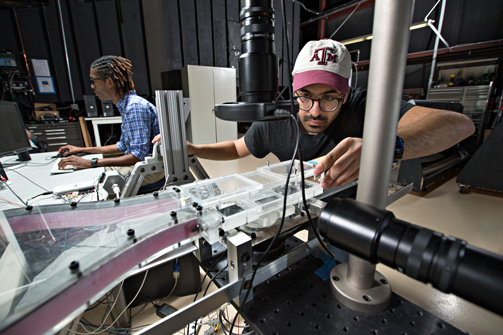Researchers with the Departments of Mechanical Engineering and Aerospace Engineering at Texas A&M University are taking complex interactions between drops of water and material surfaces and conducting fundamental research to understand why some droplets adhere to surfaces and why others don’t.
The research has applications in many industries, and the team hopes that by using the fundamental understanding they have gained, their findings have the potential to be applied to a variety of scenarios to improve the efficiency, safety and effectiveness of industrial machines and equipment.
 “The underlying principle we are seeking to study with this is very commonplace and yet very complex,” said Dr. Sungyon Lee, an assistant professor in mechanical engineering. “On a rainy day, you can just look out the window and see the water droplets and wonder, ‘Why do some of the droplets run down the window and others don't?’ We are studying ways to answer this fundamental concept because of the applications it can have elsewhere.”
“The underlying principle we are seeking to study with this is very commonplace and yet very complex,” said Dr. Sungyon Lee, an assistant professor in mechanical engineering. “On a rainy day, you can just look out the window and see the water droplets and wonder, ‘Why do some of the droplets run down the window and others don't?’ We are studying ways to answer this fundamental concept because of the applications it can have elsewhere.”
Lee explains that this common phenomenon has applications in industries like transportation, oil and gas, engineering construction, color ink jet printing and many others. For example, a key challenge that faces aircraft engineers is that because of the altitude and speed at which aircraft operate, water droplets that remain on the wings during flight are able to freeze over on the wing and endanger the craft. Lee’s research can provide a better fundamental understanding of why droplets may still adhere to an aircraft wing in those conditions and allow designers and engineers to create the wings in such a way that the droplets will no longer stick, making the plane safer.
“It isn't an easy question to answer,” Lee said “But if we take this scenario with a bunch of droplets on a wing surface and now you have wind pushing those droplets, it becomes even more complicated as the forces and factors that cause these phenomena are increased. It turns out that predicting that threshold between what makes a droplet stick and what makes it run off a surface is not trivial at all, so there are a lot of fundamental questions we can ask even in a simple scenario.”

Lee co-authored an article, “Droplet Depinning in a Wake,” which was published as a rapid communication in the journal Physical Review Fluids.
The research is part of a project funded by the National Science Foundation and is being co-investigated by Dr. Edward White, associate department head and associate professor in the aerospace engineering department. White and his students had been exploring at what point droplets roll off at exposure to different wind speeds, interested in aircraft applications. Lee was able to bring her knowledge of interfacial phenomena in fluid mechanics, or how two phases like water and a surface meet and interact, to help White in his research and they became co-investigators on the project. Lee is the principal investigator and is excited to see how the team’s research can be applied more broadly.
“I like fundamental, beautiful problems like this and it is just the tip of the iceberg,” Lee said. “Fundamental research is another way of changing the world by understanding the world better and gaining something much deeper that can be applied to a variety of areas in a much broader sense.”